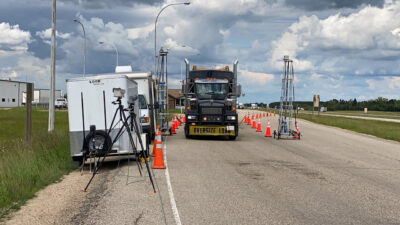Emissions project monitoring pollution on Alberta roads
By Alejandra Pulido-Guzman - Lethbridge Herald on July 22, 2022.
 Remote sensing technology towers measure emissions from the exhaust of a loading truck in northern Alberta.Photo submitted by Opus Inspection, Inc.
Remote sensing technology towers measure emissions from the exhaust of a loading truck in northern Alberta.Photo submitted by Opus Inspection, Inc.LETHBRIDGE HERALDapulido@lethbridgeherald.com
A project set to test the emissions profile of Alberta vehicles is taking place for the third time ever, this time focused on heavy duty transport trucks at the commercial vehicle inspection stations.
The Clean Air Strategic Alliance first measured the emissions of Alberta vehicles in 1998, then in 2006 and now in 2022. The project is called Roadside Optical Vehicle Emissions Reporter III (ROVER III).
“We started the project a couple of years ago, but we started sampling for data emissions last year doing light duty vehicles, so things like cars, trucks and vans, commuter vehicles and now during summer, we’re testing for heavy duty transport trucks at the commercial vehicle inspection stations,” said Andre Asselin, executive director of Clean Air Strategic Alliance.
He said they hired a contractor from the United States that specializes in this kind of work and they use remote sensing technology.
“What they do is they set up boxes up high near where the exhaust plume comes out of the truck, and they shoot light beams into them and they can figure out what is in the emissions just based on the data they gather so they’ll collect something like 60,000 data points and then put together a report for us and will give us an idea of what’s in the emissions plume,” said Asselin.
He explained that as the trucks drive by, the boxes shoot beams of light through the exhaust and they snap a picture of the license plate so they can figure out what type of vehicle it is, what year it is, what kind of fuel it burns, make and model.
“And then they are able to corroborate the emissions data with the type of vehicle, and will provide us with the report that tells us what kind of vehicles are producing the worst emissions or the most emissions, or if people have perhaps tampered with their emissions control functions and then we’ll take that information and develop recommendations for management actions and probably give them to the government and industries that are involved in trucking,” said Asselin.
He said they are trying to provide some recommendations on how to improve air quality from the transportation fleet.
“What we’re really looking for is the nitrogen oxides emissions, particulate matter, carbon monoxide and carbon dioxide as well as all volatile organic compounds as those are all elements that contribute to bad air quality,” said Asselin.
He said they want to know what is out there, what is coming out of the vehicle fleet because it does have an impact on things like human health and environmental health.
Asselin said the first time they did the project in 1998 they noticed a big difference between the cars that were produced before 1994 and those produced after.
“What happened in that time frame is that the federal government changed the standards for fuel efficiency and in burning fuel, so we learned that cars that were sort of made back in the early 90s emitted way more pollution than cars that were built after 1994,” said Asselin.
He said after finding that out, they partnered with the City of Calgary and another organization to essentially do a “retire your ride incentive” that provided some funds to those vehicle owners that had really old vehicles, which were among the worst polluters, to help get them off the road.
“We basically helped pay people to get new cars that produced way fewer emissions,” said Asselin.
He said on their second report in 2006 they were able to report those findings.
“It was a very successful program and we’re looking forward to the results of the next set of data that we’ll collect, and that’ll probably come out in 2023,” said Asselin.
Follow @APulidoHerald on Twitter
19-18


